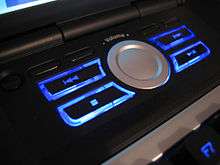Media controls
In digital electronics, analogue electronics and entertainment, the user interface of media may include media controls or player controls, to enact and change or adjust the process of watching film or listening to audio. These widely known symbols can be found in a multitude of software products, exemplifying what is known as dominant design.
Symbols

These are common icons on physical devices and application software. They are commonly found on portable media players, VCRs, DVD players, record players, remote controls, tape players and multimedia keyboards. Their application is described in ISO/IEC 18035.
The main symbols date back to the 1960s, with the Pause symbol having reportedly been invented at Ampex during that decade for use on reel-to-reel audio recorder controls, due to the difficulty of translating the word "pause" into some languages used in foreign markets. The Pause symbol was designed as a variation on the existing square Stop symbol and was intended to evoke the concept of an interruption or "stutter stop".[1][2]
| Symbol | Unicode | Name / function | ISO 7000 / IEC 60417 | |
|---|---|---|---|---|
| |
▶️ | Play | #5107B Normal run; Normal speed | “To identify the switch or switch position by means of which a normal run (e.g. of tape) is started in the indicated direction.” |
| |
⏸ | Pause | #5111B Pause; Interruption | “To identify the control or the indicator which stops operation intermittently and keeps the equipment in operating mode” |
| ⏯ | Play/Pause toggle | — | ||
| ◀️ | Reverse | — | ||
| |
⏹ | Stop | #5110B Stop | “To identify the control or the indicator to stop the active function.” |
| |
⏪ | Rewind (Fast Backwards) | — | |
| |
⏩ | Fast forward | #5108B Fast run; fast speed | “To identify the switch or switch position by which a faster than normal run (e.g. of tape) is started in the indicated direction.” |
| |
⏮ | Skip to the start or previous file/track/chapter | (#5862 Previous; to play previous part) | “To identify the control or the indicator to skip back to the top of the previous section, play the section and then stop.” |
| |
⏭ | Skip to the end or next file/track/chapter | #5861 Next; to play next part, #1116 Movement with normal speed in direction of arrow to a fixed position | “To identify the control or the indicator to play the next part and then stop.” |
| |
⏺ | Record | #5547 Recording, general | “To identify a control to preset or start a recording mode.” |
| |
⏏ | Eject | #5459 Eject | “To identify the control for the eject function.” |
| |
🔀 | Shuffle | — | |
| |
🔁 | Repeat (indefinitely) | #0026 Automatic cycle; semi-automatic cycle, #5557 Auto reverse continuously | “To indicate an automatic sequence of machine functions repeated continuously without manual intervention.” “To identify a feature or a selector control that reverses automatically the tape running direction every time the tape comes to either of its limits.” |
| 🔂 | Repeat once | — | ||
| ℹ️ | Info | #6222 Information, general; help, general | “To identify the control to examine the status of the equipment” | |
| 🔄 | Reload, Refresh | — | ||
| Replay, Play again, Play from start | #5125A Recapitulate | “To identify the control or the indicator which permits rapid access within a recorded programme to repeat the section which has just been played.” | ||
See also
References
- ↑ "Origin of play, stop, pause, etc. buttons? - Straight Dope Message Board". 2015-04-03. Retrieved 2016-09-03.
- ↑ "The Secret Histories of Those @#$%ing Computer Symbols". Gizmodo. 2010-08-16. Retrieved 2016-09-03.